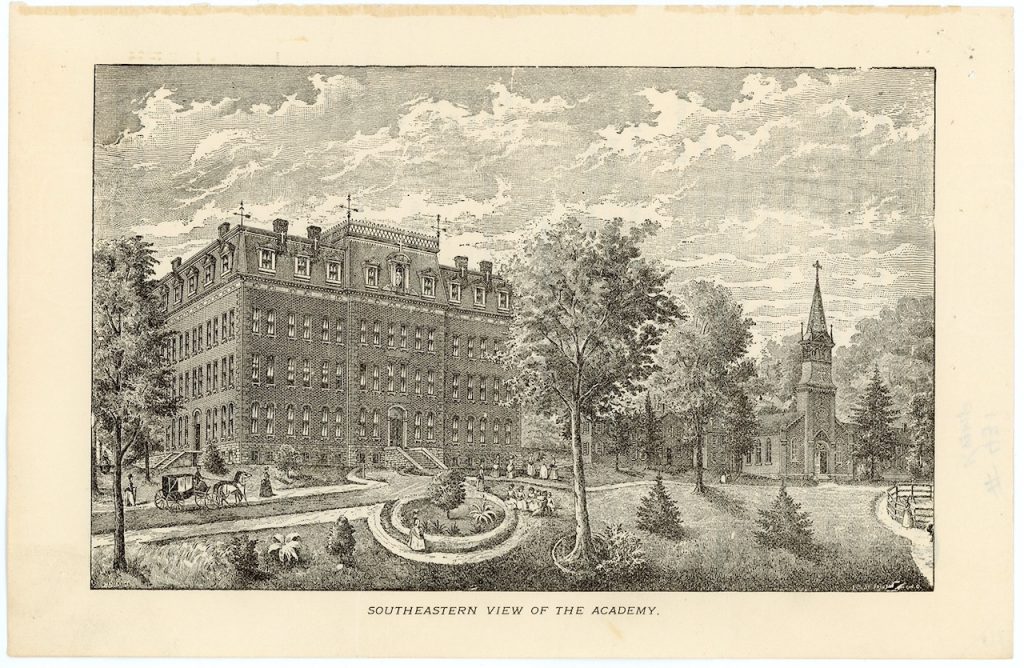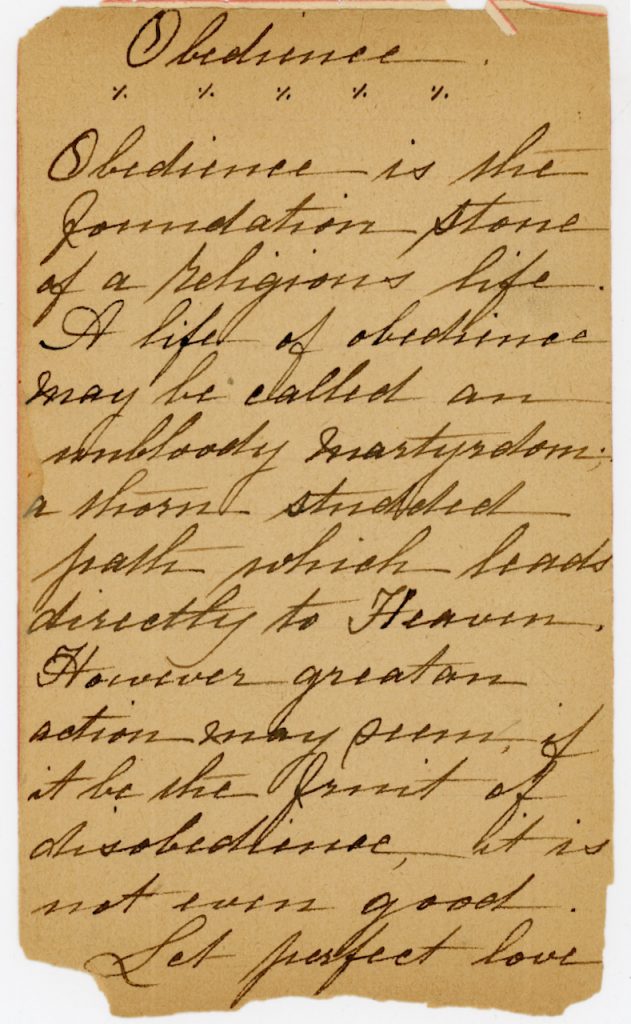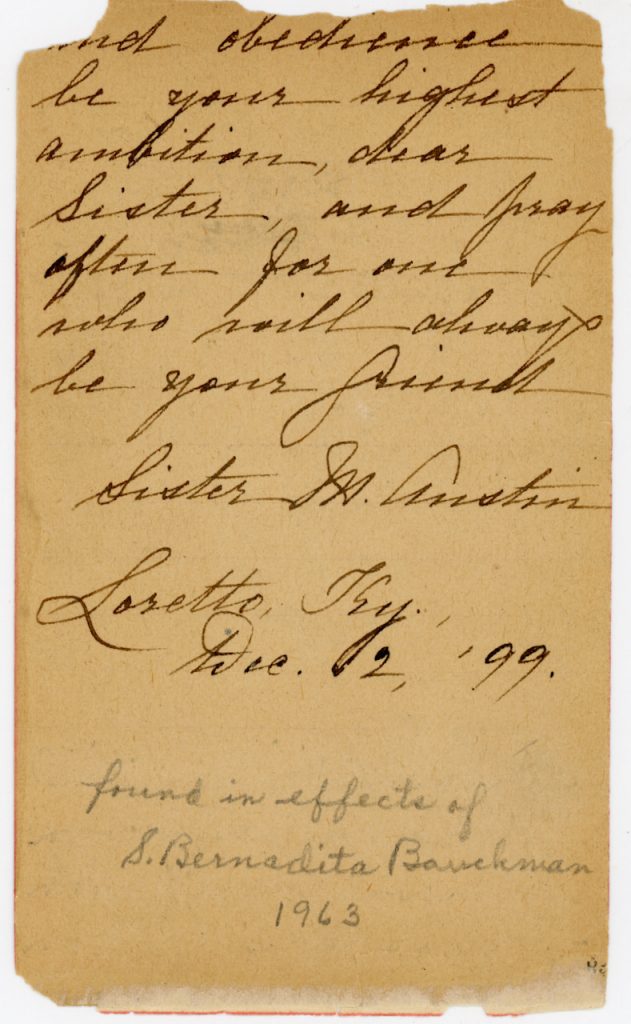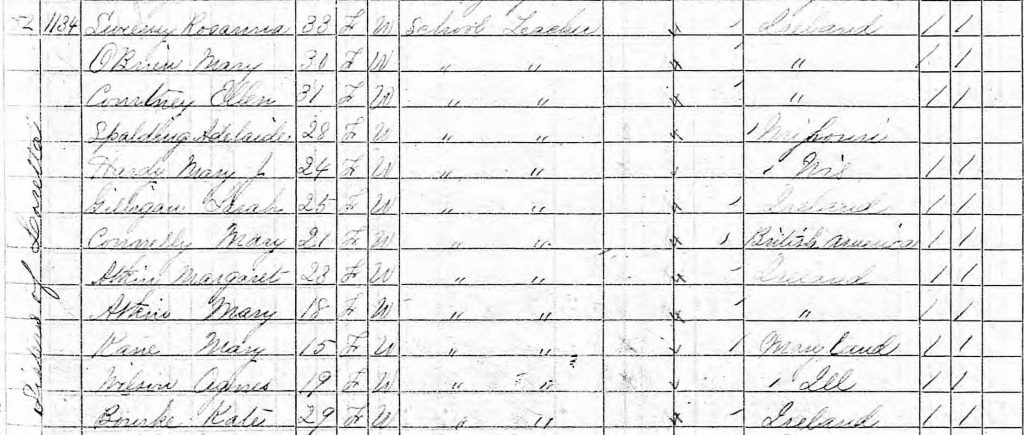The Sisters Who Left for Chicago
Posted on February 22, 2022, by Susanna Pyatt
On June 9, 1864, a Sister once lauded as “the idol and admiration of all those under her care” walked out of the Loretto convent in Cairo, Illinois, taking with her three other Sisters of Loretto.1 Their departure was unauthorized, leading to the expulsion of all four Sisters from the congregation. It was certainly not the first time a Sister had left after deciding that life in the Loretto order was not for her, but it was the only incident where a Sister convinced others to follow her away from the congregation to live together as their own religious community.
While it came as a shock to Loretto’s leadership, the roots of this departure lay in years of unrest and scheming on the part of the group’s ringleader, Sister Ferdinand Sweeney. Born around 1832, Ferdinand joined Loretto as a young woman and quickly stood out to others in the congregation as pious, virtuous, and wise.2 This led to her being given access to French spiritual books, which one account says she “devoured” but which proved unsuitable reading for Ferdinand.3 According to historian Anna C. Minogue, “The study of writings beyond her spiritual capacity, with a consciousness, now enlarged to inflation, of her inherent powers, overbalanced a character originally finely poised, and Sister Ferdinand began to dream of a reform in the Society, saw herself acclaimed the St. Teresa of the Lorettines.”4
As Ferdinand rose in the leadership ranks of Loretto, there was evidence that she did not follow expectations in fulfilling her duties. Appointed Novice Mistress in Florissant, Missouri, Ferdinand was revered by the novices but, as one later recounted, she did not teach the novices about the authority of the Loretto Motherhouse and the Mother General’s General Council—authority that was integral to the Lorettine vow of obedience. She also may have been overly strict in her discipline with the novices.5 By 1862, Ferdinand and several other Sisters had a plan to leave Loretto and found their own house. It is unclear just what reform they wanted to make, though accounts mention Ferdinand aspiring to “higher perfection” as she began to advance through the order’s leadership.6 One Sister later stated that she believed Ferdinand wanted to possess property in her own name and tried to use Loretto to accomplish this, even after she knew she had lost her vocation as a woman religious.7 Whatever the reason, several other Sisters were drawn to Ferdinand’s charisma and ideas of reform. At least one Sister believed that Loretto required too much work of them.

From the Loretto Heritage Center collections.
Mother Eleanora Clarke at Florissant was alerted to Ferdinand’s scheme, and Ferdinand was removed as Novice Mistress. It is unclear if Loretto leadership believed Ferdinand to be repentant or if they thought changing her position would appease her, because they next sent her to open St. Mary’s School in St. Louis and then to open the school at Cairo. In 1863, it became impossible to ignore Ferdinand’s lack of attention to proper Loretto protocols. Among her offenses at Cairo was a failure to report back from the new foundation to the Motherhouse. After the Council received a “pert reply” when they reprimanded Ferdinand, they recalled her to Kentucky and assigned her to wardrobe or infirmary work at St. Mary’s College. Here, Ferdinand “feigned penitence” and “played semi-invalid” until the Council once again sent her to a new assignment, this time in the American West.8
En route to her new placement, Ferdinand pulled one more trick: she called Mother Elizabeth Hayden to St. Louis on a pretense, then went to Cairo while Mother Elizabeth was gone and attempted to usurp her position. This effort failed, and within a few days Ferdinand departed from Cairo, leaving Loretto for good. She took with her Sisters Jane Frances O’Brien, Erminildes Courtney, and Alfrida Spalding. Sister Austin Gough also prepared to leave with the group but was convinced at the last minute by the local priest and Mother Elizabeth that she would be making a grave error.


Meditation on obedience written by Sr. Austin Gough, 1899. From the Loretto Heritage Center collections.
Stymied from taking control of the Cairo convent, Ferdinand set out with her followers for Chicago, Illinois, where they formed an independent “Sisters of Loretto” community for the next seven years. The small group founded their own convent and taught school for St. Patrick’s Parish. There they were joined by Sister of Loretto Bernardine Ryan. All of the Sisters involved so far had been on the faculty with Ferdinand in either St. Louis or Cairo. They successfully invited one more Sister, Marcelline Lewis, to join them in Chicago, but Marcelline “returned to Loretto almost as soon as train would bring her, not liking the way affairs went on in Chicago.”9 Marcelline happily lived out the rest of her life teaching at schools in Illinois and Kentucky.
While the Sisters’ new community in Chicago had success with running the school, affairs inside the convent deteriorated. Ferdinand avoided attending most spiritual exercises and eventually stopped going to Mass, claiming illness prevented her from participating. It is unclear from later accounts just what this illness was, but there is indication of both mental “melancholy,” possibly linked to romantic affairs, and physical ailment.10 Ferdinand did not keep financial records for the school and convent, and accounts indicate that she spent frivolously, hiring carriages and over-purchasing personal remedies from the drugstore. Ten young women entered the Chicago order, with seven continuing to the Chicago community’s novitiate, but Ferdinand did not prepare them well for taking final vows. The Sisters kept the Loretto Rule, though Ferdinand gradually made changes to it and intended to submit the re-written Constitutions to Rome for approval. Sister Alfrida reported that the Sisters kept silence only as they pleased and did not hold Chapters or regular permissions, which were part of the structure and vow of obedience of Loretto.

Image courtesy of Ancestry.com.
While the Sisters were at first too busy with their work to notice Ferdinand’s poor health and the lapses in her leadership, by the summer of 1871, they were discontented. Ferdinand resigned as the Superior, and the bishop decided to disband the community rather than appoint another Superior. The Sisters dispersed. Bernardine had been dismissed from the Chicago community earlier and applied for re-entry to Loretto. In early 1868, the Loretto Council barred Bernardine from returning and decided that none of the Sisters who had made final vows and then left with Ferdinand would be allowed to re-enter the order. Bernardine continued teaching for some years, taking over a parish school from two Sisters of Mercy and continuing to wear the habit despite no longer being a member of any religious order.11
After the Chicago community disbanded, Alfrida applied to the Religious of the Sacred Heart and then to a Visitation convent, neither of which would receive women who had been part of other orders. She did join another Visitation convent in Maysville, Kentucky, for three months, but did not find it suitable for her. With the support of local bishops, she re-applied to Loretto and was accepted back, as she had not yet taken final vows when she left with Ferdinand. Alfrida took the name Bridget upon re-joining Loretto, made her final vows in 1878, and taught at schools in Kentucky and Missouri until her death in 1927.
The other Sisters likewise found orders to join. Jane Frances spent a period of time with an Ursuline community, after which she joined the Dominican Sisters of St. Cecilia in Nashville, took the name Sister Cecilia, and taught at schools in Tennessee until her death in 1917. Erminildis may have joined the Sisters of St. Joseph, and most of the Chicago novices are said to have joined other orders as well. Erminildis had discouraged the novices from going to Loretto, reporting that the work there was too hard.
As for Ferdinand, she continued in poor health and died from cancer on May 1, 1875, at Mercy Hospital in Chicago. The final account of her states that Ferdinand received a deathbed visit from a Jesuit priest, and thus “the wandering sheep availed herself of this crowning mercy and made her peace with God.”12
Footnotes
1 Prior to joining Loretto, Ferdinand was briefly a postulant in another order, possibly the Sisters of Notre Dame (Document for the General Council, in personnel file of Sr. Ferdinand Sweeney, Loretto Heritage Center).
2 Account of Sr. Bridget Spalding, 1922, in personnel file of Sr. Ferdinand Sweeney, Loretto Heritage Center.
3 “A Sad Defection,” 1911, in personnel file of Sr. Ferdinand Sweeney, Loretto Heritage Center.
4 Anna C. Minogue, Loretto: Annals of the Century (New York: American Press, 1912), p. 182. At one point, Sr. Ferdinand may have been ascribed healing powers, as the Document for the General Council mentions Sr. Ferdinand was said to have made several cures in her early days at Florissant.
5 Document for the General Council.
6 “A Sad Defection.”
7 Account of Sr. Bridget Spalding.
8 Ibid.
9 Personnel file of Sr. Marcelline Lewis, Loretto Heritage Center.
10 Document for the General Council.
11 Ibid.
12 “A Sad Defection.”

A part of history that we didn’t know a thing about. You are an amazing story-teller, Susanna. I read your blog for Sister Anthony Mary, and we both learned a lot! Keep looking in those Archival boxes!